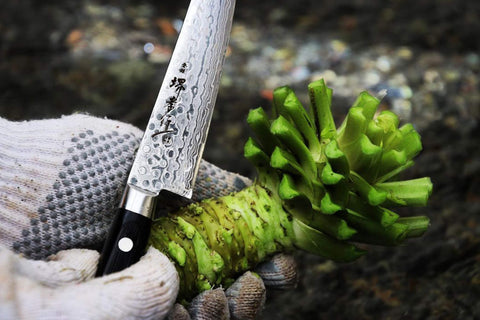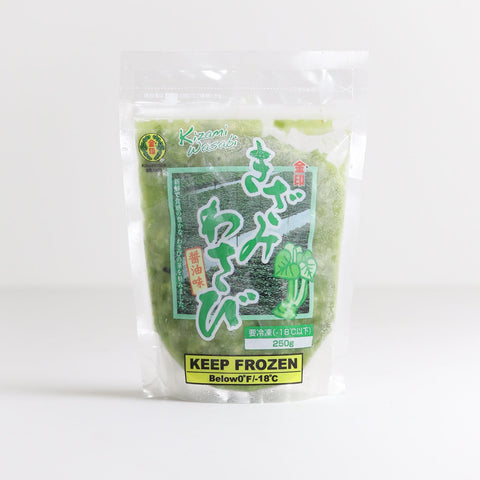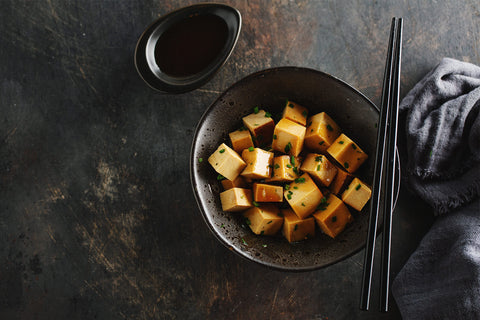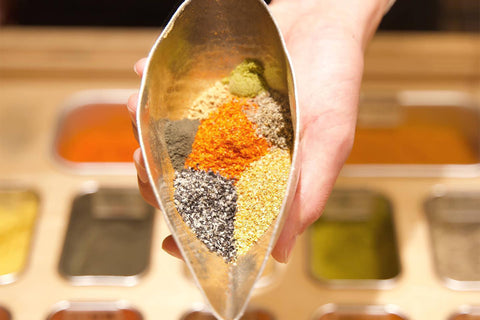
What is Wasabi?
Wasabi (also known as Japanese horseradish) is a plant from the brassica family, which also includes mustard and horseradish. It’s perhaps the most well-known Japanese condiment outside of its native country, even most commercial wasabi sold in Western supermarkets is actually a different variety of horseradish coloured green with food dye.
History
Wooden strips dating back to the Asuka period (538 to 710) have been excavated from the remains of Enchi in the Nara Prefecture of Japan, containing the names of several plants likely to have been grown in the area. Among them was a mention of wasabi, among a series of medicinal planets, suggesting that this powerfully-flavoured vegetable was used for medicinal purposes. This theory is backed up by the later discovery of the word wasabi in Japan’s oldest encyclopaedia of medicinal plants, the Honzo Wamyo, dating from the Heian period (794 to 1185). Wasabi is also mentioned in a collection of laws and customs from the same period – the Engishiki, which notes that it was collected as a tax.
Wasabi was first deliberately cultivated in the early Edo period and began to be used in its common form, as a condiment for sushi, in the early 19th century.
Cultivation
Wasabi grows naturally in mountain river valleys in Japan and can be found wild alongside stream beds. It is notoriously difficult to cultivate wasabi on a wide scale, as it requires very specific conditions for successful growth. This includes high levels of humidity during the summer months, an air temperature of between 8 and 20 °C, and minimal exposure to direct sunlight.
As a result, cultivation is difficult even under optimal conditions and there are few places in Japan that are suitable for growing on an industrial scale. Most wasabi in Japan comes from the Izu Peninsula, in Shizuoka Prefecture, and the Nagano, Iwate, and Shimane prefectures.
Such is the demand for wasabi in Japan, the country imports the plant from special cultivation facilities as far afield as Israel, Taiwan, Thailand, New Zealand, and the United States. There are even Japanese wasabi farms in Europe, including Hungary, Iceland, the Netherlands and the UK.
Uses of wasabi
Wasabi is sold as a rhizome (the part of the stem that grows underground) or the stem itself, either of which needs to be finely-grated before use. It can also be sold as a dried powder, or as a prepared paste, usually sold in tubes.
Some restaurants prepared wasabi paste fresh for each dish, using a metal grater (oroshigane) for the job. If left uncovered, fresh wasabi paste will lose its flavour in under 15 minutes. When preparing sushi using fresh wasabi paste, chefs will often layer the wasabi between the rice and the fish to preserve its flavour.
A popular snack in Japan is wasabi-mame (wasabi beans). This comprises various legumes, including peas, peanuts, and soybeans, that are fired or roasted and then coated with a mixture of wasabi powder, salt, and sugar.
Wasabi graters
In restaurant settings, wasabi is usually grated using a metal oroshigane. A more traditional method uses a tool made from dried sharkskin, and grater made with shark’s teeth have also been employed for the purpose.
Flavour
Freshly-grated wasabi packs a powerful punch, as anybody who has tasted it will readily attest. Though it has a pungent aroma and plenty of heat, both of these dissipate quickly in the mouth, and actually highlight the taste of fish, rather than covering it.
Wasabi’s famous heat is short-lived compared to chilli peppers of a similar strength. This is because the heat is not oil-based like it is in capsaicin. The heat of wasabi is experienced largely in the nose and sinuses, rather than the mouth, where it is quickly washed away by food, drink, or saliva. Deliberately inhaling the vapour from wasabi can result in a painful sensation in the nasal cavity, as can consuming too much wasabi paste in a single sitting.
Surrogates
Because wasabi requires optimal growing conditions for successful cultivation, it has become impossible for growers to be able to satisfy the commercial demand. Genuine Japanese wasabi therefore tends to be rather expensive. As such, many alternatives have been produced to satisfy the demand for this popular condiment.
A common substitute, known in Japan as seiyō (or Western) wasabi, is a mixture of horseradish, starch, and mustard, coloured with spinach dye or green food colouring.
Popular Products
These are just some of the popular wasabi products and variations that prove particularly popular at SushiSushi.
Kinjirushi Kizami Wasabi
This frozen wasabi paste contains large quantities of wasabi, including the shredded stem and roots of the wasabi plant, delivering incredible taste and texture. With 39% real wasabi included, this produces a unique flavour to go with any sushi dish.
Kameya Real Shredded Shizuoka Wasabi
Forget the Westernised version of wasabi – this is the real deal. Kameya oroshi wasabi is authentic grated wasabi, using fresh ingredients sourced directly from Shizuoka, Japan, with not even a hint of horseradish included in its production. The perfect condiment for sushi and sashimi, of course, it also goes well with beef and other meat-based dishes.
Large Shark Skin & Japanese Cedar Wasabi Grater
For the authentic wasabi experience, invest in this beautiful traditional oroshigane. Made of shark skin and Japanese cedar, this specialist instrument is used in the very best restaurants across Japan.
Our Suppliers
Here at SushiSushi, we source our wasabi from some of the most well-respected and established producers in Japan. These include:
Kameya Foods
Kameya Foods was established in 1947, initially as a manufacturer of Japanese pickles. Its location in Shizuoka, near the base of Mount Amagi, allowed the company to available themselves of Japan’s best-quality wasabi that grows at its edge.
Kinjirushi
Kinjirushi combines the best natural ingredients with state-of-the-art cultivation techniques to produce delicious Japanese wasabi that is burst with flavour and that bold, powerful heat that is its trademark.
S&B Foods
Since 1923, S&B Foods has been an innovator in spices, condiments, and other cooking ingredients. Indeed, they were one of the first companies to sell wasabi in a tube, allowing for greater distribution across the globe.













